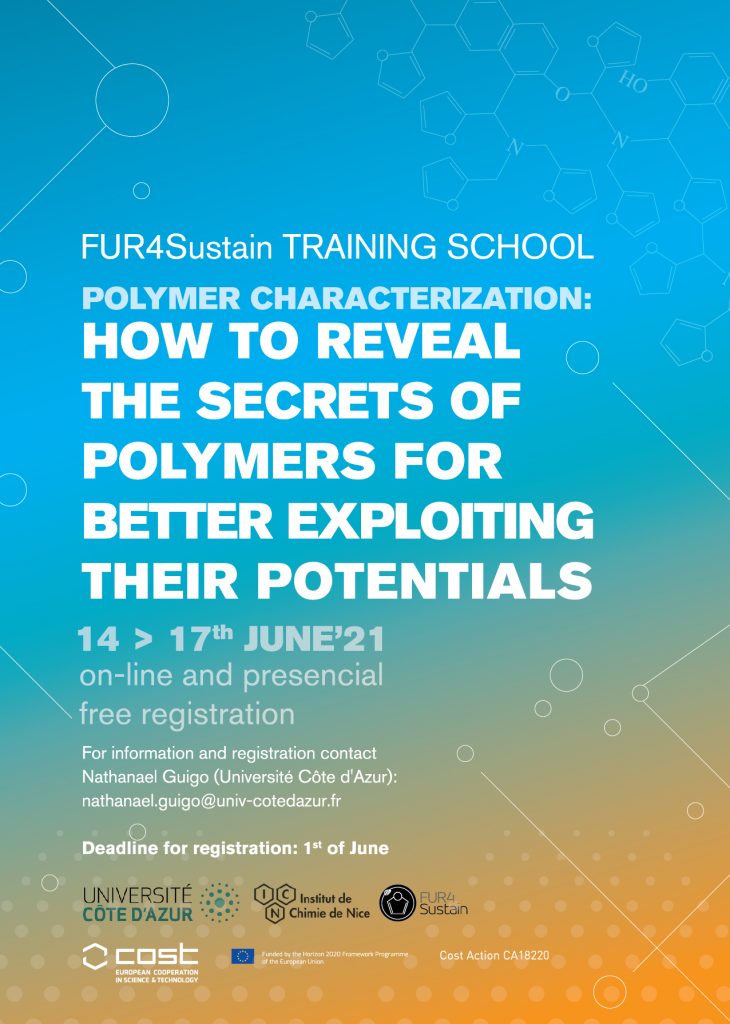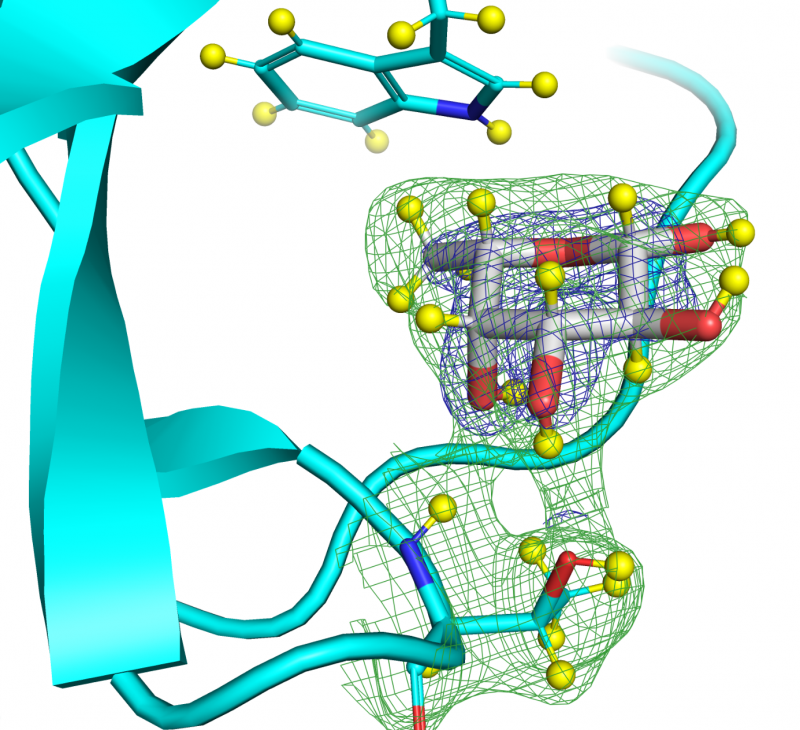Antoine Rousseau thesis defense on December 16th , 2021
Antoine Rousseau completed his thesis at Cermav under the co-supervision of Sébastien Fort (CNRS Research Director) and Sylvie Armand (Lecturers at Université Grenoble Alpes). It is entitled “Peptidoglycan oligomers synthesis to study the bacterial cell wall metabolism”. Click on the title for more information.
Video : Hamed Ahmadi-Nohadi research work
Discover the manufacture of micro / nanofiber layers by the electrospinning method developed in Hamed Ahmadi-Nohadi’s thesis under the supervision of Issei Otsuka, thanks to funding from Labex Arcane.
Click on the title to access the video.
Dania Martínez-Alarcón thesis defense on September 17th, 2021
Dania Martínez-Alarcón completed her thesis within the framework of the European network PhD4GlycoDrug. It was co-directed by Annabelle Varrot (Director of Research CNRS, in our lab) and Roland Pieters (Utrecht University in the Netherlands). The subject of her thesis is the following : “Characterization of lectins from emergin fungi and identification from fungal extracts”. Click on the title for more information.
Maxime Leprince thesis defense on September 24th, 2021
Maxime Leprince completed his thesis in co-supervision between our laboratory (under the co-supervision of Prof. Rachel Auzély) and the CEA – Department of Biology and Health Technologies “DTBS”, Chemistry, Sensors and Biomaterials laboratory “L2CB” (under the co-supervision of Dr Isabelle Texier-Nogue). The subject of his thesis is the following “Design of polysaccharide-based conductive inks and hydrogels for the development of controllably biodegradable bioelectronics devices”. Click on the title to access the summary.
Wei Li thesis defense on July, 26th 2021
This thesis was completed in our laboratory, under the supervision of Dr. Yoshiharu NISHIYAMA. The subject is: “Preparation of cellulose oligomers by acid hydrolysis.” Click on the title for more information.
Computational Modeling in Glycoscience
Advancements in high-performance computing have allowed molecular simulation methods to play a more substantial role in supporting experiments and transcend such mandate to guide experimental design and lead autonomously scientific discovery. This review presents the foundations underlying the multiscale molecular simulations methods, from atomistic to coarse-grained, used in complex carbohydrate research. The applications to glycan and glycoconjugates, polysaccharides, proteins-glycans interactions,… illustrate the relevance of computer simulations to the field of glycoscience. Click on the title for more information.
Electrospun Cellulosic Membranes toward Efficient Chiral Resolutions via Enantioselective Permeation
Many biologically-active compounds, such as drugs, agrochemicals, food additives, etc. have chiral structures (like right- and left-hands) and their physiological properties usually depend on their chirality. In this study, cellulose tris(3,5-dimethylphenylcarbamate) (CDMPC), known as one of the most versatile chiral selectors packed in columns for chiral chromatography, is electrospun for the first time to fabricate an enantioselective membrane toward efficient chiral
resolutions. We believe that such a novel electrospun cellulosic membrane having both the enantioselective permeation property and the capacity to be used in pressure-driven filtration processes is a significant step forward toward large-scale chiral resolutions. Click on the title for more information.
Electrospun Polysaccharidic Textiles for Biomedical Applications
We are publishing a new review on electrospun polysaccharide textiles for biomedical applications, in a new open access journal entitled Textiles, which covers studies in the field of textile science and industry. Click on the title for more information.
Proteome-wide prediction of bacterial carbohydrate-bindingproteins as a tool for understanding commensal and pathogencolonisation of the vaginal microbiome
Bacteria use carbohydrate binding proteins (CBP), such as lectins and carbohydrate binding modules (CBMs), to anchor themselves to specific sugars on host surfaces. This study provides new insight into the potential mechanisms of colonization by commensals and potential reproductive tract pathogens that underlie health and disease states. Click on the title for more information.
Juliette Francillon thesis defense on June 25th, 2021
Juliette Francillon completed her thesis in co-supervision between our laboratory, under the direction of Dr. Claire Boisset, and the laboratory
Papermaking Process Engineering Laboratory (LGP2) – UMR CNRS 5518 – Grenoble INP – Agefpi in Grenoble, under the direction of Prof. Christine Chirat.
Her thesis is entitled: “Study of the molecular diversity of soluble hemicellulose oligosaccharides derived from wood autohydrolysates.”
Rafael Bermeo thesis defense on June, 18th 2021
Rafael Bermeo will defend his thesis on June 18th, 2021, which he performed under the supervision of Dr. Annabelle Barrot (CNRS Research Director at Cermav – UPR5301) and which is entitled “Design, synthesis and evaluation of antagonists towards BC2L-C ”. Click on the title for more information.
Morphological and Structural Aspects of α-Glucan Particles from Electron Microscopy Observations

The book “Enzymology of Complex Alpha-Glucans”, edited by Felix Nitschke, will be published in July 2021. The first of the 11 chapters is devoted to the morphological and structural study of starch granules and glycogen using electron microscopy various techniques.
Fur4Sustain training school on ‘Polymer Characterization’

341 / 5000
Résultats de traduction
We are pleased to announce the first FUR4Sustain training school on “Characterization of polymers” with the intervention of Dr Laurent Heux and Jean-Luc Putaux. The event will be held at the Université Côte d’Azur in Nice (FR) from June 14 to 17 (face-to-face or virtual via zoom). Click on the title for more information.
Lukáš Gajdoš thesis defense on May, 20th 2021
Lukáš Gajdoš from Cermav-UPR5301 and Institut Laue-Langevin in Grenoble will defend his thesis entitled: “Neutron diffraction for deciphering lectin-glycan interactions involved in bacterial infection”. Click on the title for more information.
Temperature-triggered formation of a cellulose II nanocrystal network through regioselective derivatization
We took advantage of the antiparallel arrangement of the chains within the cellulose II nanocrystals to graft gold nanoparticles or thermosensitive polymer chains to both ends of these rods. In the latter case, a temperature variation induces the formation of a network with a gel-like behaviour by the end-to-end association of the rods.
Visualisation of hydrogen atoms in a perdeuterated lectin-fucose complex reveals key details of protein-carbohydrate interactions

The pathogenic bacteria attach themselves to the cells which they attack thanks to the sugars present on their membrane. A crucial mechanism to study, because it would help to treat these infections without reinforcing the resistance of the bacteria. To do this, researchers from CERMAV (CNRS), the Laue-Langevin Institute (ILL) and CEITEC (Masaryk University, Czech Republic) have modified a sugar so that it responds to neutron crystallography, a technique that reveals how bacteria cling to sugars. This work, published in the journal Structure, could extend to more complex sugars to better understand different biological phenomena and propose new anti-infectious strategies. Caption: Fucose molecule in the lectin binding site. The blue grid represents the density determined by x-rays and the green grid the density determined by the neutrons around the fucose and the amino acids of the lectin. Hydrogen atoms (here isotope deuterium) are represented by yellow balls. The continuity of the green grid between the fucose and the amino acids allows a direct view of the hydrogen bonds. © L. Gajdos. / Click on the title for more information.
Replay: Serge Perez’s seminar: “Starch: An iconoclast view on amylopectin”, presented at the 7th “Special Infogest Webinar on Food Digestion”
Click on the title for more information
Small Angle Neutron Scattering Shows Nanoscale PMMA Distribution in Transparent Wood Biocomposites
« Transparent wood » can be prepared by filling the pores with resine, but how are the resine distributed. By small angle neutron scattering on samples with varyous the isotope composition of the resine we showed unambiguouslly the nanomeric ditribution of resine in the interstices of microfibrils in the cell wall. Click on the title to access more information.
Crystal and molecular structure of V-amylose complexed with ibuprofen
We have published an article in Carbohydrate Polymers about the structure of an inclusion compound prepared by crystallizing amylose in the presence of ibuprofen, a well-known anti-inflammatory drug. Using data from solid-state NMR, and electron and X-ray diffraction, we have proposed a molecular model allowing to locate the ibuprofen guest molecules in the lattice of amylose helices. Click on the title for more information.
Process-dependent nanostructures of regenerated cellulose fibres revealed by small angle neutron scattering
The nanostructure and properties of regenerated cellulose fibers depends on the spinning process. We revealed different structures by collecting small angle neutron scattering data on a series of fibers exposed to heavy water vapours. Click on the title for more information.
Daniel Marquez-Martin thesis defense on March, 16th 2021
Daniel Marquez-Martin from Cermav-UPR5301 and SyMMES- UMR5819 laboratories will defend his thesis entitled: “Versatile biosensor for deciphering glycoenzymatic activities”. Click on the title for more information.
Breakdown and buildup mechanisms of cellulose nanocrystal suspensions under shear and upon relaxation probed by SAXS and SALS
In this study supervised by Frédéric Pignon (LRP, Grenoble), the complementary use of small-angle scattering of light (structure at the microscopic scale) and X-rays (structure at the nano scale) allowed us to revisit the mechanism of orientation under flow of suspensions of cellulose nanocrystals in the liquid-crystal phase. Click on the title for more information.
Interview
Redouane Borsali, CNRS Research Director at Cermav, was interviewed in the latest newsletter from the North-East Asia CNRS office (on February 2021) about his research activities and the launch of an international research project with National Taiwan University (NTU) entitled “New ultra-nanostructured and stretchable biomaterials for
design of bio-electronic devices ”. Click on the title for more information.
INFOGEST Webinar Series on Food Digestion: ‘Starch: An iconoclast view on amylopectin’
Mar 15, 2021 11:00 AM in Dublin.
Click on the title for more information.
